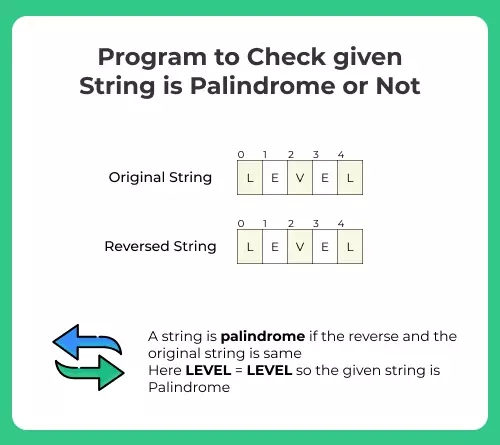0
Notifications Mark All Read
- Login
- Get Prime
Program to check whether a String is a Palindrome or not in Python
What are Palindromes?
A palindrome is a word, phrase, or sequence that reads the same backwards as forwards. They can be both numeric and characters. For instance –
All above are examples of palindrome as they are same when read forwards/backwards

Write a program to Check whether a String is Palindrome or not in python
Methods discussed
- Method 1: Using String Slicing
- Method 2: Matching ith character from front-back
- Method 3: Matching ith character from front-back (Updated)
- Method 4: Inbuilt function
- Method 5: Building using arithmetic
- Method 6: Building using flag
- Method 7: Negative Traversal in loop

Method 1
This method uses negative slicing to generate reverse of string
# Write a program to check whether a string is palindrome or not in python
input_string = 'civic'
rev = input_string[::-1]
if input_string == rev:
print(rev + " is Palindrome")
else:
print(rev + " is not Palindrome")
Output
civic is Palindrome
Method 2 (Matching ith character from front-back)
For string check, if each i-th character from the front is the same as i-th character from back or not.
If yes then its a palindrome
Python Code
def isPalindrome(input_str):
# check if input_str[i] is same as input_str[len(str) - i - 1]
# for each char in string
for i in range(0, len(input_str)):
# Essentially, what is being checked isif i-th character is
# equal to i-th character from the end or not
if input_str[i] != input_str[len(input_str) - i - 1]:
return False
return True
input_str = "civic"
print("Palindrome") if isPalindrome(input_str) else print("Not Palindrome")
Output
civic is Palindrome
Method 3 (Matching ith character from front-back, updated)
It’s very similar to the previous method, with one difference that –
Rather than checking ith character from the front is the same as the ith character from the back for the whole string.
We just check for the first half of the string, since, if the string is Palindrome. The first half and second half when read backwards will anyways be the same.
Python Code
def isPalindrome(input_str):
# Run loop from 0 to len/2
mid = int(len(input_str) / 2)
for i in range(0, mid):
# Essentially, what is being checked isif i-th character is
# equal to i-th character from the end or not
if input_str[i] != input_str[len(input_str) - i - 1]:
return False
return True
input_str = "civic"
print("Palindrome") if isPalindrome(input_str) else print("Not Palindrome")
Output
civic is Palindrome
Method 4 (inbuilt function)
We will use inbuilt reversed function to do it in this method
# main function
string = "civic"
reverse = ''.join(reversed(string))
print(string + " is: ", end="")
print("Palindrome") if string == reverse else print("Not Palindrome")
Output
civic is: Palindrome
Method 5 (Building reverse using arithmetic)
We build the reverse using arithmetic here
input = "civic"
# this will automatically generate reverse
rev = ""
for ch in input:
rev = ch + rev
print(input + " is : ", end="")
print("Palindrome") if input == rev else print("Not Palindrome")
print("string: " + input)
print("rev: " + rev)
Output
civic is : Palindrome
string: civic
rev: civic
Method 6 (Building reverse using flag)
We build the reverse using flag here
input = "civic"
j = -1
flag = 0
for char in input:
# char starts from index 0
# string[j] forces to read from end
# bcz negative index are read from end
if char != input[j]:
flag = 1
break
j = j - 1
print(input + " is : ", end="")
print("Not Palindrome") if flag else print("Palindrome")
Output
civic is : Palindrome
Method 7 (Negative traversal in Loop)
We build the reverse using Negative traversal in Loop
input = "civic"
n = len(input)
revlist = []
for i in range(n - 1, -1, -1):
revlist.append(input[i])
rev = "".join(revlist)
print(input + " is: ", end="")
if input == rev:
print("Palindrome")
else:
print("Not Palindrome")
Output
civic is : Palindrome
Prime Course Trailer
Related Banners
Get PrepInsta Prime & get Access to all 200+ courses offered by PrepInsta in One Subscription
- Length of the string without using strlen() function : C | C++ | Java | Python
- Toggle each character in a string : C | C++ | Java | Python
- Count the number of vowels : C | C++ | Java | Python
- Remove the vowels from a String : C | C++ | Java | Python
- Check if the given string is Palindrome or not : C | C++ | Java | Python
- Print the given string in reverse order : C | C++ | Java | Python
- Remove all characters from string except alphabets : C | C++ | Java | Python
- Remove spaces from a string : C | C++ | Java | Python
- Remove brackets from an algebraic expression : C | C++ | Java | Python
- Count the sum of numbers in a string : C | C++ | Java | Python
- Capitalize the first and last character of each word of a string : C | C++ | Java | Python
- Calculate frequency of characters in a string : C | C++ | Java | Python
- Find non-repeating characters in a string : C | C++ | JAVA | Python
- Check if two strings are Anagram or not : C | C++ | Java | Python
- Replace a sub-string in a string: C | C++ | Java | Python
- Count common sub-sequence in two strings : C | C++ | Java | Python
- Check if two strings match where one string contains wildcard characters : C | C++ | Java | Python
Login/Signup to comment

 0
0


s=input()
s1=””
for i in s:
s1=i+s1
print(s1)
if(s==s1):
print(“Palindrome”)
else:
print(“Not Palindrome”)